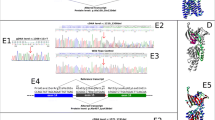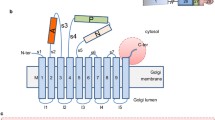Abstract
Hailey–Hailey disease (HHD; OMIM 169600) is an autosomal dominant blistering disease. Pathogenic mutations in ATP2C1 encoding the human secretory pathway Ca2+/Mn2+-ATPase protein 1 (hSPCA1) have been identified since 2000. The aim of this study was to report a Chinese pedigree and a sporadic case of HHD and to explore the genetic mutations. The Chinese pedigree and the sporadic case of typical HHD were subjected to mutation detection of ATP2C1. The 27 coding exons and their flanking sequences were amplified and sequenced. The heterozygous C to T transition at nucleotide 2753 in exon 26 and G to T transition at nucleotide 2090 in exon 21 of the ATP2C1 gene were identified in a pedigree and a sporadic case of HHD, respectively. The C2753T transition resulted in a novel nonsense mutation of glutamine codon (CAG) to a stop codon (TAG) at amino acid residue 865 (Q865X) and the G2090T transition resulted in a novel missense mutation of glycine condon (GGA) to Valine (GUA) at amino acid residue 645 (G645V) in hSPCA1. This study should be useful for genetic counseling and prenatal diagnosis for affected families and in expanding the repertoire of ATP2C1 mutations underlying HHD.


Similar content being viewed by others
References
Behne MJ, Tu CL, Aronchik I, Epstein E, Bench G, Bikle DD, Pozzan T, Mauro TM (2003) Human keratinocyte ATP2C1 localizes to the Golgi and controls Golgi Ca2+ stores. J Invest Dermatol 121:688–694
Dobson-Stone C, Fairclough R, Dunne E, Brown J, Dissanayake M, Munro CS, Strachan T, Burge S, Sudbrak R, Monaco AP, Hovnanian A (2002) Hailey–Hailey disease: molecular and clinical characterization of novel mutations in the ATP2C1 gene. J Invest Dermatol 118:338–343
Hu Z, Bonifas JM, Beech J, Bench G, Shigihara T, Ogawa H, Ikeda S, Mauro T, Epstein EH Jr (2000) Mutations in ATP2C1, encoding a calcium pump, cause Hailey–Hailey disease. Nat Genet 24:61–65
Kitajima Y (2002) Mechanisms of desmosome assembly and disassembly. Clin Exp Dermatol 27:684–690
Li H, Sun XK, Zhu XJ (2003) Four novel mutations in ATP2C1 found in Chinese patients with Hailey–Hailey disease. Br J Dermatol 149:471–474
Sudbrak R, Brown J, Dobson-Stone C, Carter S, Ramser J, White J, Healy E, Dissanayake M, Larregue M, Perrussel M, Lehrach H, Munro CS, Strachan T, Burge S, Hovnanian A, Monaco AP (2000) Hailey–Hailey disease is caused by mutations in ATP2C1 encoding a novel Ca2+ pump. Hum Mol Genet 9:1131–1140
Zhu YG, Yang S, Gao M, Chen JJ, Li W, Wang PG, Zhou HL, Zhao XY, Ren YQ, Xiao FL, Du WH, Zhang XJ, Zhou FS, Shen YJ (2006) Two novel mutations of the ATP2C1 gene in Chinese families with Hailey–Hailey disease. J Dermatol Sci 42(2):125–127
Acknowledgments
We would like to thank the patients for participating in the study. This work was supported by grant from the Natural Science Foundation of China (30471564).
Author information
Authors and Affiliations
Corresponding authors
Additional information
This work was supported by grant from the Natural Science Foundation of China (30471564).
Rights and permissions
About this article
Cite this article
Li, X., Xiao, S., Peng, Z. et al. Two novel mutations of the ATP2C1 gene in Chinese patients with Hailey–Hailey disease. Arch Dermatol Res 299, 209–211 (2007). https://doi.org/10.1007/s00403-007-0761-x
Received:
Revised:
Accepted:
Published:
Issue Date:
DOI: https://doi.org/10.1007/s00403-007-0761-x




